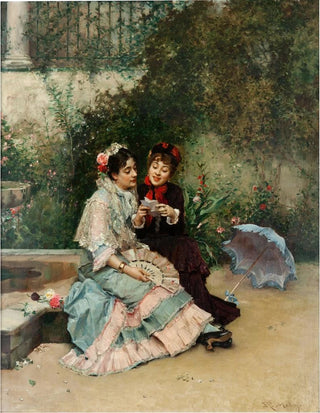Art print | La Lettre - Raimundo de Madrazo y Garreta


View from behind

Frame (optional)
In the rich and nuanced universe of art, some works manage to transcend their era to touch the hearts of viewers. "The Letter" by Raimundo de Madrazo y Garreta is a striking example. This painting, which evokes an intimate and delicate scene, immerses us in a suspended moment where time seems to stand still. The composition, both simple and profound, invites us to explore the emotions of the characters while awakening our curiosity about the story that unites them. The elegance of this piece lies in its ability to spark imagination, transporting us to a space where beauty and melancholy meet.
Style and uniqueness of the work
Madrazo's style is characterized by striking realism, combined with a particular sensitivity to light and color. In "The Letter," every detail is carefully orchestrated, from the folds of the fabric to the expressions on the faces, creating an atmosphere that is both warm and mysterious. The artist excels in depicting human emotions, and this painting is no exception. The woman, the central figure of the work, appears both absorbed in reading the letter and aware of our gaze. This duality creates a unique connection between the artwork and the viewer, prompting us to wonder about the content of the letter and the feelings it might evoke. The color palette, soft and harmonious, reinforces this sense of intimacy and reflection.
The artist and his influence
Raimundo de Madrazo y Garreta, born in Spain in the 19th century, is a painter whose work is often associated with the realist movement. Son of a renowned artist, he developed a personal style, blending French and Spanish influences. His career is marked by a constant quest for beauty and emotion, values he conveyed through his paintings. Madrazo also had an impact on his contemporaries, inspiring a new generation of artists to explore the subtleties of daily life and human relationships. His works, often tinged with nostalgia, reflect a time of great change, where traditions mingle with new ideas. "The Letter" is one such example.

Matte finish

View from behind

Frame (optional)
In the rich and nuanced universe of art, some works manage to transcend their era to touch the hearts of viewers. "The Letter" by Raimundo de Madrazo y Garreta is a striking example. This painting, which evokes an intimate and delicate scene, immerses us in a suspended moment where time seems to stand still. The composition, both simple and profound, invites us to explore the emotions of the characters while awakening our curiosity about the story that unites them. The elegance of this piece lies in its ability to spark imagination, transporting us to a space where beauty and melancholy meet.
Style and uniqueness of the work
Madrazo's style is characterized by striking realism, combined with a particular sensitivity to light and color. In "The Letter," every detail is carefully orchestrated, from the folds of the fabric to the expressions on the faces, creating an atmosphere that is both warm and mysterious. The artist excels in depicting human emotions, and this painting is no exception. The woman, the central figure of the work, appears both absorbed in reading the letter and aware of our gaze. This duality creates a unique connection between the artwork and the viewer, prompting us to wonder about the content of the letter and the feelings it might evoke. The color palette, soft and harmonious, reinforces this sense of intimacy and reflection.
The artist and his influence
Raimundo de Madrazo y Garreta, born in Spain in the 19th century, is a painter whose work is often associated with the realist movement. Son of a renowned artist, he developed a personal style, blending French and Spanish influences. His career is marked by a constant quest for beauty and emotion, values he conveyed through his paintings. Madrazo also had an impact on his contemporaries, inspiring a new generation of artists to explore the subtleties of daily life and human relationships. His works, often tinged with nostalgia, reflect a time of great change, where traditions mingle with new ideas. "The Letter" is one such example.






